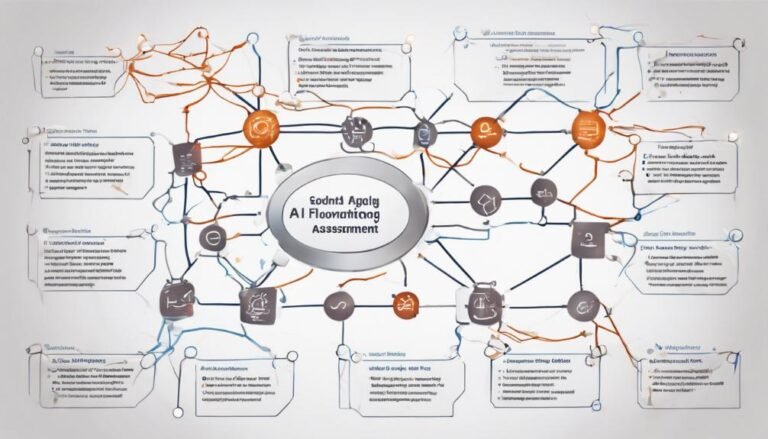AI in High-Frequency Trading
Artificial intelligence has revolutionized high-frequency trading, ushering in a new era of unparalleled speed and accuracy in financial markets. With AI systems processing vast amounts of data instantaneously and making split-second trading decisions, the landscape of trading has been transformed. The utilization of advanced algorithms and predictive analytics has given rise to a level of precision and efficiency that was previously unattainable. As we explore the intricate interplay between AI and high-frequency trading, it becomes evident that the implications and outcomes are far-reaching, shaping the future of financial markets in ways that demand further examination.
Key Takeaways
- AI leverages predictive analytics for informed trading decisions.
- Machine learning algorithms optimize risk assessment and trading parameters.
- Real-time data analysis enhances trade execution efficiency.
- AI algorithms reduce latency for faster transactions.
- AI technology revolutionizes high-frequency trading practices.
Evolution of High-Frequency Trading
The evolution of high-frequency trading has been marked by rapid advancements in technology and sophisticated algorithms, revolutionizing the financial markets.
Technological advancements have played an essential role in shaping the landscape of high-frequency trading, enabling traders to execute thousands of trades per second with minimal latency. This shift has intensified market competition, pushing firms to continuously innovate and enhance their trading strategies to gain a competitive edge.
Data analysis has become a cornerstone of high-frequency trading, with firms leveraging vast amounts of market data to inform their trading decisions in real-time. The ability to process and interpret data swiftly has greatly improved trading efficiency, allowing for faster and more accurate trade executions.
As a result, high-frequency traders can capitalize on fleeting market opportunities and adjust their positions rapidly in response to changing market conditions. The evolution of high-frequency trading continues to be driven by advancements in technology, data analysis, and the quest for greater trading efficiency in an increasingly competitive market environment.
Role of Artificial Intelligence
Artificial intelligence plays a pivotal role in high-frequency trading through its utilization of predictive analytics and algorithmic trading strategies. These technologies enable AI systems to analyze vast amounts of data in real-time, identifying patterns and trends that human traders might miss.
Ai's Predictive Analytics
Utilizing sophisticated algorithms and advanced machine learning techniques, AI's predictive analytics play an essential role in high-frequency trading by analyzing vast amounts of data to forecast market trends with unparalleled speed and accuracy. Machine learning algorithms enable AI systems to process and interpret massive datasets in real-time, identifying patterns and correlations that human traders might overlook.
Through continuous data analysis, AI can quickly adapt to changing market conditions and make split-second decisions to capitalize on opportunities or mitigate risks.
The predictive analytics capabilities of AI in high-frequency trading go beyond traditional methods by incorporating historical data, real-time market feeds, and even social media sentiment analysis. By leveraging these diverse sources of information, AI algorithms can generate predictive models that help traders anticipate market movements and optimize trading strategies.
This data-driven approach enables AI systems to deliver actionable insights at a pace that surpasses human capabilities, giving traders a competitive edge in the fast-paced world of high-frequency trading.
Algorithmic Trading Strategies
AI's integration into high-frequency trading is revolutionizing algorithmic trading strategies by leveraging advanced computational methodologies. Machine learning algorithms play a vital role in enhancing these strategies by enabling systems to learn from data, adapt to market conditions, and make intelligent decisions in real-time.
These algorithms analyze vast amounts of data at speeds beyond human capabilities, identifying patterns and trends that inform trading decisions.
Quantitative analysis is another key component of algorithmic trading strategies powered by AI. By utilizing mathematical and statistical models, traders can assess risk, identify opportunities, and optimize trading parameters with precision.
AI systems can process complex data sets, perform sophisticated calculations, and execute trades with minimal latency, giving firms a competitive edge in high-frequency trading environments.
Incorporating machine learning algorithms and quantitative analysis into algorithmic trading strategies allows for the automation of decision-making processes, leading to increased efficiency, reduced human error, and improved profitability.
As technology continues to advance, the role of AI in high-frequency trading is poised to grow, shaping the future of financial markets.
Benefits of AI Integration
The integration of AI in high-frequency trading offers significant benefits.
AI algorithms enable trading firms to execute trades at lightning speeds, capitalizing on market opportunities before human traders can react.
Additionally, AI can analyze vast amounts of data in real-time, leading to more informed and precise trading decisions.
Speeding up Transactions
Enhancing transaction speed through the integration of AI technologies has proven to be a strategic advantage in high-frequency trading environments. By leveraging AI-driven solutions, firms can achieve significant improvements in latency reduction, enhancing order execution efficiency, and optimizing transaction speed to capitalize on market liquidity.
- Latency Reduction: AI algorithms can analyze market data and execute trades at incredibly high speeds, reducing latency to milliseconds or even microseconds.
- Order Execution: AI-powered systems can swiftly process large volumes of orders, ensuring quick and accurate execution in rapidly changing market conditions.
- Transaction Speed: AI enables real-time data analysis and decision-making, allowing for faster transactions and increased responsiveness to market movements.
- Market Liquidity: With AI, firms can better navigate market liquidity by swiftly identifying and capitalizing on trading opportunities, leading to improved overall performance and profitability.
Incorporating AI in high-frequency trading not only enhances operational efficiency but also provides a competitive edge by enabling firms to execute trades with unmatched speed and precision.
Enhancing Decision-Making Accuracy
By integrating AI technologies, high-frequency trading firms can greatly enhance the accuracy of their decision-making processes, leading to more informed and precise trading strategies. Machine learning algorithms and predictive modeling play an essential role in analyzing vast amounts of data at high speeds, identifying patterns, and making predictions that humans alone would struggle to achieve. Through machine learning, AI systems can continuously learn from new data, adapt to changing market conditions, and improve decision-making accuracy over time.
| Benefits of AI Integration in High-Frequency Trading | |||
|---|---|---|---|
| Enhanced Decision-Making Accuracy | Increased Efficiency | Risk Mitigation | Real-Time Data Analysis |
| AI optimizes trading decisions based on data analysis | Streamlining processes and reducing costs | Identifying and managing potential risks | Analyzing large volumes of data in real-time |
In essence, the integration of AI technologies empowers high-frequency trading firms to make more precise and data-driven decisions, ultimately enhancing their competitive edge in the market.
Risks and Challenges Faced
In the landscape of high-frequency trading, the integration of AI presents a myriad of risks and challenges that demand meticulous attention and strategic mitigation strategies.
As AI algorithms become more prevalent in trading practices, the following risks and challenges emerge:
- Data Security: The vast amounts of sensitive financial data processed by AI systems pose a significant risk if not properly secured, potentially leading to breaches and data leaks.
- Market Manipulation: AI-powered trading algorithms have the potential to manipulate markets through rapid and automated trading decisions, raising concerns about market fairness and integrity.
- Algorithmic Bias: AI models can exhibit biases based on the data they are trained on, leading to skewed decision-making processes that may not reflect the true market conditions.
- Regulatory Compliance: Adapting existing regulations to encompass AI-driven trading strategies presents a challenge in ensuring fair and transparent market practices while harnessing the benefits of AI technologies.
Impact on Market Dynamics
The introduction of AI into high-frequency trading has profoundly altered market dynamics, influencing the speed, volume, and complexity of trading activities. AI-driven algorithms can execute trades at speeds far beyond human capabilities, impacting liquidity and price volatility in financial markets.
While enhanced liquidity can improve market efficiency, excessive AI trading volume can lead to sudden price fluctuations, potentially increasing volatility.
However, this increased speed and volume of trades also raise concerns about market manipulation and ethical implications. The rapid execution of trades by AI systems can potentially be exploited to manipulate prices or create artificial market trends.
Regulators are increasingly focusing on monitoring and regulating AI-driven trading activities to prevent market abuse and uphold market integrity.
The integration of AI in high-frequency trading has unquestionably transformed market dynamics, offering new opportunities for market participants but also presenting challenges related to maintaining fair and transparent markets.
As AI continues to evolve in trading practices, addressing these ethical concerns and monitoring its impact on liquidity and price volatility will be vital for ensuring a well-functioning financial ecosystem.
Regulatory Considerations
Regulatory frameworks play an essential role in overseeing the integration of AI technology in high-frequency trading and ensuring market integrity. When it comes to AI in high-frequency trading, regulatory considerations are critical to maintain a fair and transparent market environment.
Key points to bear in mind include:
- Compliance Monitoring: Regulators focus on how AI is used for compliance monitoring, ensuring that trading activities adhere to relevant laws and regulations.
- Surveillance Technology: Utilizing advanced surveillance technology is important to detect and prevent potential market abuses in high-frequency trading.
- Market Manipulation: Regulators need to address how AI may be employed to manipulate markets unfairly, safeguarding against artificial price movements.
- Insider Trading: Preventing insider trading through the use of AI requires robust regulatory oversight to maintain market fairness and investor confidence.
Future Trends and Innovations
In addition to the rapid evolution of AI technology and its impact on high-frequency trading, the future trends and innovations in this space are poised to revolutionize market dynamics and trading strategies.
Machine learning advancements and predictive modeling are expected to play a pivotal role in enhancing trading algorithms and decision-making processes. By leveraging sophisticated algorithms and historical data, predictive modeling can anticipate market trends with greater accuracy, enabling traders to make more informed decisions in real-time.
Automation efficiency is another key trend that is set to transform high-frequency trading. Automated systems can execute trades at speeds far beyond human capabilities, enabling traders to capitalize on fleeting market opportunities instantly.
Real-time data insights will continue to be a driving force in high-frequency trading innovations as well. By analyzing vast amounts of data in real-time, traders can identify patterns, trends, and anomalies, allowing for quicker reactions to market fluctuations.
Conclusion
To sum up, the integration of artificial intelligence in high-frequency trading has revolutionized the financial landscape, enhancing speed, accuracy, and efficiency in trade execution.
As the adage goes, 'time is money,' AI-powered systems have greatly reduced latency, enabling lightning-speed transactions and real-time data analysis.
Despite facing challenges and regulatory considerations, the future of high-frequency trading lies in further advancements in AI technology, paving the way for more efficient and effective trading strategies.







